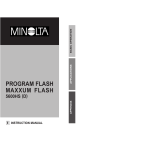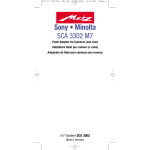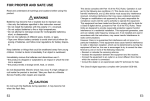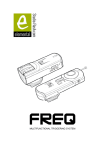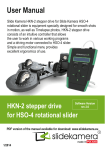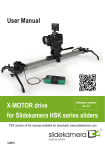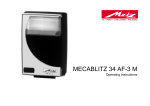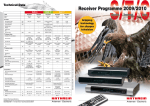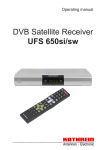Download Metz Mecablitz 36 AF-3C Operating instructions
Transcript
702 47 0059.A1 D,F,NL,GB,I,E 24.07.2002 8:42 Uhr Seite 1 TV. VIDEO. AUDIO. MECABLITZ MECABLITZ 36 AF-3 C/M/N Bedienungsanleitung Mode d’emploi Handleiding Operating Instructions Norme per l’uso Instrucciones del manejo 702 47 0059.A1 D,F,NL,GB,I,E 24.07.2002 Contents Indice Contenido 82 8:42 Uhr Seite 82 1. Safety instructions 2. 2.1 2.2 2.3 Supported dedicated functions mecablitz 36 AF-3 C mecablitz 36 AF-3 M mecablitz 36 AF-3 N 96 96 98 100 90 3. 3.1 3.2 Mounting the mecablitz Mounting the mecablitz on the camera Removing the mecablitz from the camera 102 102 104 4. 4.1 4.2 4.3 Power supply Suitable batteries Replacing batteries Switching the flash unit on and off 106 106 108 110 5. 5.1 5.2 5.3 5.4 5.4.1 Dedicated functions and flash mode Flash readiness indication Automatic flash sync speed control Correct exposure indication Displays in the camera viewfinder mecablitz 36 AF-3 C 112 112 114 116 118 120 702 47 0059.A1 D,F,NL,GB,I,E 24.07.2002 Contents Indice Contenido 84 8:42 Uhr Seite 84 5.4.2 5.4.3 5.5 5.6 5.7 5.7.1 5.7.2 5.7.3 5.8 mecablitz 36 AF-3 M mecablitz 36 AF-3 N Zoom reflector AF measuring beam TTL flash mode Automatic TTL fill-in flash in daylight Matrix-controlled fill-in flash (Nikon) Manual TTL flash exposure correction Establishing the maximum flash range with the aperture calculator 122 124 124 126 130 132 136 136 6. Programmed Auto Flash Mode 144 7. 7.1 7.2 7.2.1 7.2.2 7.2.3 Flash techniques Bounce flash Flash synchronisation Normal synchronisation REAR - Second-curtain synchronisation Slow synchronisation / SLOW 146 146 150 150 150 152 8. Maintenance and care 154 140 702 47 0059.A1 D,F,NL,GB,I,E 24.07.2002 Contents Indice Contenido 86 8:42 Uhr 9. 9.1 Seite 86 Technical data Guide number table for full light output, metric system 156 160 702 47 0059.A1 D,F,NL,GB,I,E 24.07.2002 8:42 Uhr Seite 88 Foreword Foreword Premessa Welcome to the large family of Metz customers! We congratulate you on purchasing this flash unit and thank you for your confidence in our products. Introducción It is only natural that you should want to use your flash unit straight away. However, we recommend that you study these Operating Instructions beforehand to be able to fully exploit and utilize all the capabilities offered. This flash unit is only suitable for the following camera brands: • mecablitz 36 AF-3 C only for Canon EOS cameras • mecablitz 36 AF-3 M only for Minolta Dynax or. Minolta Maxxum cameras • mecablitz 36 AF-3 N only for Nikon cameras. Please refer to section 2 of this manual for the suitable camera types. 88 702 47 0059.A1 D,F,NL,GB,I,E 24.07.2002 Safety instructions Per la vostra sicurezza Instrucciones de seguridad 8:42 Uhr Seite 90 1. Safety instructions • The flash unit is exclusively intended and approved for photographic use! • Never fire a flash in the vicinity of flammable gases or liquids (petrol, solvents, etc.)! DANGER OF EXPLOSION! • Never take flash shots of car, bus or train drivers, or of motorcycle and bicycle riders, whilst they are travelling. They could be blinded by the light and cause an accident! • Never fire a flash in the immediate vicinity of the eyes! Flash fired directly in front of the eyes of a person or animal can damage the retina and lead to severe visual disorders - even blindness! • Only use the approved power sources listed in the Operating Instructions! • Do not expose batteries to excessive heat, sunshine, fire and the like! • Never throw exhausted batteries on to a fire! 90 702 47 0059.A1 D,F,NL,GB,I,E 24.07.2002 Safety instructions Per la vostra sicurezza Instrucciones de seguridad 8:42 Uhr Seite 92 • Exhausted batteries should be immediately removed from the flash unit. Lye leaking out of spent batteries will damage the unit. • Never recharge dry-cell batteries! • Do not expose the flash unit or battery charger to dripping or splashing water (such as rain)! • Protect the flash unit from excessive heat and humidity! Do not store the flash unit in the glove compartment of a car! • Never place material that is impervious to light in front of, or directly on, the reflector screen. The reflector screen must be perfectly clean when a flash is fired. The high energy of the flash light will burn the material or damage the reflector screen if this is not observed. • Do not touch the reflector screen after a series of flash shots. Danger of burns! 92 702 47 0059.A1 D,F,NL,GB,I,E 24.07.2002 Safety instructions Per la vostra sicurezza Instrucciones de seguridad 8:42 Uhr Seite 94 • Never disassemble the flashgun! DANGER: HIGH VOLTAGE! There are no components inside the flashgun that can be repaired by a layman. • When taking a series of flash shots at full light output and fast recycling times as provided by NiCad battery operation, make sure to observe an interval of at least 10 minutes after 15 flashes, otherwise the flash unit will be overloaded. • The mecablitz may only be used in combination with a camera-integrated flash unit if the latter can completely be folded out! • Quick changes in temperature may cause condensation. Therefore give the flashgun time to acclimatize! 94 96 • • • • • • EOS 5, 10, 10S, 500, 5000, EOS A2, A2E, Kiss, 888, EOS REBEL X, REBEL XS EOS 700, 750, 850 • • • EOS 1V, 3, 30, 33, 50, 50E, EOS 300, 500N, EOS ELAN II, ELAN IIE, ELAN 7E, EOS REBEL 2000, REBEL G, EOS New Kiss, Kiss III, EOS IX, IX E, IX 7, IX Lite, IX 50 EOS 1, 1N, 100, 100QD, 600, 620, 630, 650, 650QD, 1000, 1000N, 1000F, 1000FN, 3000, REBEL, REBEL S, REBEL SII,EOS ELAN, EOS RT, EOS 88 Tipo de cámara Canon Camera Canon Canon camera type 702 47 0059.A1 D,F,NL,GB,I,E 24.07.2002 • • • x • • • • • x • 8:42 Uhr Seite 96 2. Supported dedicated functions 2.1 mecablitz 36 AF-3 C • = Dedicated function is supported x = Dedicated function is performed by the camera or must be set on the camera Flash ready indication in camera viewfinder Automatic flash sync speed TTL flash control Manual TTL-flash exposure correction AF measuring beam control Programmed auto flash mode 98 700si, 650si, 600si • ◊ • • x x • • • ◊ • • x x • • 4, 505si super, 505si, XTsi, HTsi, 500si super, 500si, 400si, 404si,303si, 7xi, 5xi, 3xi, SPxi, 5000i, 5700i, Vectis S-1 5, 7, 800si 24.07.2002 Dynax / Maxxum Minolta camera type Camera Minolta Tipo de cámara Minolta 702 47 0059.A1 D,F,NL,GB,I,E 8:42 Uhr Seite 98 2.2 mecablitz 36 AF-3 M • = Dedicated function is supported x = Dedicated function is performed by the camera or must be set on the camera ◊ = Only in the camera modes A, S and M • ◊ • • Flash ready indication in camera viewfinder Automatic flash sync speed TTL flash control Automatic TTL flash exposure correction Manual TTL-flash exposure correction 1st or 2nd curtain synchronisation • • AF measuring beam control Programmed auto flash mode • • • • x x • • 100 • • • • x x x • • • 8:42 Uhr Seite 100 2.3 mecablitz 36 AF-3 N • • • • • • • • • • • • • • x • • • • • • x = Dedicated function is performed by the camera or must be set on the camera FM-3A FA, FE-2, FG, EM • = Dedicated function is supported F60, N60, F50, N50 F501, N2020, F401, N4004, F401s, N4004s, F301, N2000 F601M, N6000 • • • • x x x 24.07.2002 F5, F4s, F4, F100, F90X, N90S, F90, N90, F801s, F801, N8008s, N8008 F601, N6006 F70, N70, Pronea 600i, Pronea 6i Tipo de cámara Nikon Camera Nikon Nikon camera type 702 47 0059.A1 D,F,NL,GB,I,E • Flash ready indication in camera viewfinder • Automatic flash sync speed • TTL flash control Automatic TTL flash exposure correction Matrix controlled TTL fill-in flash mode x Manual TTL-flash exposure correction 1st or 2nd curtain synchronisation AF measuring beam control Programmed auto flash mode 702 47 0059.A1 D,F,NL,GB,I,E 24.07.2002 Mounting the mecablitz Montaggio del mecablitz Montaje del mecablitz 8:42 Uhr Seite 102 3. Mounting the mecablitz 3.1 Mounting the mecablitz on the camera ☞ Turn off the camera and the mecablitz by their main switch. mecablitz 36 AF-3 C and 36 AF-3 N • Turn the knurled nut against the mecablitz housing until the stop point is reached. • Slide the mecablitz foot completely into the camera’s accessory shoe. • Turn the knurled nut against the camera body as far as possible, thereby clamping the mecablitz. mecablitz 36 AF-3 M • Slide the mecablitz foot completely into the camera’s accessory shoe. • Lightly press the unlatching button “PUSH” upward to clamp the mecablitz in the camera’s accessory shoe. 102 702 47 0059.A1 D,F,NL,GB,I,E 24.07.2002 Mounting the mecablitz Montaggio del mecablitz Montaje del mecablitz 8:42 Uhr Seite 104 3.2 Removing the mecablitz from the camera ☞ Turn off the camera and the mecablitz by their main switch. mecablitz 36 AF-3 C and 36 AF-3 N • Turn the knurled nut against the mecablitz housing until the stop point is reached. • Withdraw the mecablitz from the camera’s accessory shoe. mecablitz 36 AF-3 M • Press the unlatching button “PUSH” towards the flash unit and at the same time hold it lightly down until the “PUSH” button locks in place. • Withdraw the mecablitz from the camera’s accessory shoe. 104 702 47 0059.A1 D,F,NL,GB,I,E 24.07.2002 8:42 Uhr Seite 106 Power Supply 4. Power supply Alimentazione 4.1 Suitable batteries Alimentación de corriente The mecablitz can be operated with any of the following batteries: • 4 NiCad batteries, type IEC KR 15/51. They permit very fast recycling and are economical in use because they are rechargeable. • 4 nickel metal hydride batteries. They have a significantly higher capacity than NiCad batteries and are less harmful to the environment (no cadmium). • 4 alkaline manganese dry-cell batteries, type IEC LR6. Maintenance-free power source for moderate power requirements. ☞ Do not use lithium batteries! Their higher cell voltage may damage the electronic system of the flash unit. Remove the batteries from the mecablitz if the flash unit is not going to be used for an extended period of time. 106 702 47 0059.A1 D,F,NL,GB,I,E 24.07.2002 8:42 Uhr Seite 108 Power Supply 4.2 Replacing batteries Alimentazione The batteries are exhausted if the recycling time (elapsing from the triggering of a full-power flash to the moment the flash ready indicator lights up again) exceeds 60 seconds. Alimentación de corriente • Turn off the mecablitz by its main switch. • Slide the battery compartment cover in the direction of the arrow and fold open. • Insert the batteries lengthwise in conformity with the indicated battery symbols and close the battery compartment cover. ☞ When loading batteries ensure correct polarity, as indicated by the symbols in the battery compartment. Mixed up battery poles may destroy the flash unit! Replace all batteries at a time and make sure that the batteries are of the same brand and type and have the same capacity! 108 702 47 0059.A1 D,F,NL,GB,I,E 24.07.2002 Power Supply Alimentazione Alimentación de corriente 8:42 Uhr Seite 110 ☞ Exhausted batteries must not be thrown in the dustbin! Help protect the environment and dispose of run-down batteries at the appropriate collecting points. 4.3 Switching the flash unit on and off The flash unit is switched on by its main switch. In the right “ON” position, the mecablitz is on. To turn off the flash unit reset the main switch to its “OFF” position. 110 702 47 0059.A1 D,F,NL,GB,I,E 24.07.2002 Dedicated functions and flash mode Funzioni dedicate e modi flash Funciones dedicadas y funcionamiento del flash 8:42 Uhr Seite 112 5. Dedicated functions and flash mode 5.1 Flash readiness indication The flash readiness symbol lights up on the mecablitz when the flash capacitor is charged, thereby indicating that flashes can be fired for the next shot. Flash readiness is transmitted to the camera and displayed in the viewfinder (see camera manual). If a picture is shot before flash readiness is signalled in the camera’s viewfinder, then the flash unit will not be triggered so that the exposure may be incorrect. ☞ If flash readiness is established, a full-power test flash can be triggered with the manual firing button on the mecablitz. 112 702 47 0059.A1 D,F,NL,GB,I,E 24.07.2002 Dedicated functions and flash mode Funzioni dedicate e modi flash Funciones dedicadas y funcionamiento del flash 8:42 Uhr Seite 114 5.2 Automatic flash sync speed control Depending on the camera model and the selected mode, the camera’s shutter speed automatically changes to flash sync speed when flash readiness is reached (see operating instructions for the given camera). Shutter speeds faster than the flash sync speed cannot be set or will automatically be changed to flash sync speed. Various cameras feature a sync speed range, e.g. 1/30th sec. to 1/125th sec. (see the camera’s operating instructions). The actual sync speed used by the camera depends on the camera mode, the prevailing ambient light and the focal length of the lens. Shutter speeds that are slower than the flash sync speed can be used, depending on the operating mode selected on the camera. 114 702 47 0059.A1 D,F,NL,GB,I,E 24.07.2002 Dedicated functions and flash mode Funzioni dedicate e modi flash Funciones dedicadas y funcionamiento del flash 8:42 Uhr Seite 116 Only mecablitz 36 AF-3 M: When the flash unit is switched on with bright ambient light, ensure that in the Program P and Programmed Image Control Modes the shutter speed is not faster than the flash sync speed. In the event that the camera selects a faster speed, this can be limited to the flash sync speed by pressing the key for exposure control on the camera. An alternative way to overcome the problem is to set the “A”, “S” or “M” mode on the camera. 5.3 Correct exposure indication The “o.k.” correct exposure confirmation briefly lights up on the mecablitz when the shot was correctly exposed in TTL flash mode. If “o.k.” is not indicated after an exposure, then this means that the shot was underexposed. The shot will then have to be repeated with the next smaller f-number (e.g. f/8 instead of f/11) or the distance to the subject or the reflecting surface (e.g. when bouncing the flash) must be shortened. 116 702 47 0059.A1 D,F,NL,GB,I,E 24.07.2002 Dedicated functions and flash mode Funzioni dedicate e modi flash Funciones dedicadas y funcionamiento del flash 8:42 Uhr Seite 118 Please refer to the maximum flash range indicated on the aperture calculator of the mecablitz. Only mecablitz 36 AF-3 M: Following correct exposure the mecablitz transmits a signal to the camera with the result that correct exposure is additionally indicated in the viewfinder of some cameras (see operating instructions for the given camera). 5.4 Displays in the camera viewfinder ☞ The actual display in the camera viewfinder can deviate from the subsequent description or some symbols are only possible with certain camera models (see operating instructions for the given camera). 118 702 47 0059.A1 D,F,NL,GB,I,E 24.07.2002 Dedicated functions and flash mode Funzioni dedicate e modi flash Funciones dedicadas y funcionamiento del flash 8:42 Uhr Seite 120 5.4.1 mecablitz 36 AF-3 C • Flash symbol flashes: User is requested to use or switch on the flash unit. • Flash symbol lights up: mecablitz is ready for operation. Some cameras have a warning function in the viewfinder to indicate incorrect exposure. For instance, if the f-number or shutter speed or both of them flash in the viewfinder, then this will indicate either under- or overexposure. Basic information concerning incorrect exposure: • In the event of overexposure: Do not use the flash! • In the event of underexposure: Switch on the flash unit or mount the camera on a tripod and set a slower shutter speed. The reasons for incorrect exposure can vary in the different exposure and automatic programmes. 120 702 47 0059.A1 D,F,NL,GB,I,E 24.07.2002 Dedicated functions and flash mode Funzioni dedicate e modi flash Funciones dedicadas y funcionamiento del flash 8:42 Uhr Seite 122 5.4.2 mecablitz 36 AF-3 M • Flash symbol lights up (Flash readiness indication): Display is permanently illuminated or flashes slowly to indicate that the mecablitz is ready for firing. A flash will be fired when the camera’s shutter is released. • Flash symbol flashes (Correct exposure indication): Display flashes rapidly after shooting to confirm correct exposure. • Display flashes: Flash is required for the existing exposure situation. 122 702 47 0059.A1 D,F,NL,GB,I,E 24.07.2002 Dedicated functions and flash mode Funzioni dedicate e modi flash Funciones dedicadas y funcionamiento del flash 8:42 Uhr Seite 124 5.4.3 mecablitz 36 AF-3 N • Green flash symbol illuminated: User is requested to use or switch on the flash unit. • Red flash symbol illuminated: Flash unit is ready for firing. • Red flash symbol remains illuminated after shooting or is briefly switched off: The shot was correctly exposed. 5.5 Zoom reflector The zoom reflector of the mecablitz has four zoom positions for optimal light coverage and adaptation of the guide number to the focal length of the lens. 28 mm Wide-angle illumination for focal lengths as of 28 mm 35 mm Wide-angle illumination for focal lengths as of 35 mm 50 mm Normal illumination for focal lengths as of 50 mm 85 mm Telelens illumination for focal lengths as of 85 mm 124 702 47 0059.A1 D,F,NL,GB,I,E 24.07.2002 Dedicated functions and flash mode Funzioni dedicate e modi flash Funciones dedicadas y funcionamiento del flash 8:42 Uhr Seite 126 The zoom reflector can be swivelled upwards into four locking positions (e.g. for bounce flashes): 30°, 45°, 60° and 90°. For normal flash operation the reflector is in the horizontal position: 0°. 5.6 AF measuring beam The AF measuring beam is activated by the camera electronics when the ambient lighting conditions are insufficient for automatic focusing. The AF beam emitter then projects a striped pattern on to the subject, and the camera uses this pattern to focus automatically. enable activation of the AF measuring beam by the ☞ Tocamera, the camera lens must be set to AF. On the camera, the AF mode “Single-AF” or “ONE-SHOT-AF” must be selected. Low-speed zoom lenses may significantly reduce the distance range of the AF measuring beam. 126 702 47 0059.A1 D,F,NL,GB,I,E 24.07.2002 Dedicated functions and flash mode Funzioni dedicate e modi flash Funciones dedicadas y funcionamiento del flash 8:42 Uhr Seite 128 The striped pattern of the AF measuring beam only supports the camera’s central AF sensor. When using cameras with several AF metering areas we therefore recommend to activate the camera’s central AF metering zone. Some cameras may only activate the AF illuminator integrated in the camera. In such an event, the AF measuring beam emitter of the mecablitz will not be activated. Please refer to the corresponding information given in operating instructions for the individual camera. 128 702 47 0059.A1 D,F,NL,GB,I,E 24.07.2002 Dedicated functions and flash mode 8:42 Uhr Seite 130 5.7 TTL flash mode Funzioni dedicate e modi flash The mecablitz 36AF-3 is only suitable for the TTL flash mode. Funciones dedicadas y funcionamiento del flash The TTL flash mode is a very simple way to achieve excellent flash shots. In this mode exposure readings are taken by a sensor built into the camera which measures the light reaching the film through the camera lens (TTL). The electronic control circuit within the camera transmits a stop signal to the mecablitz as soon as the film has been exposed by the correct amount of light, thereby instantly interrupting the flash. The advantage of this flash mode is that all factors influencing correct exposure of the film (filters, change of aperture and focal length with zoom lenses, extensions for closeups, etc.) are automatically taken into account. You need not worry about setting the flash, the camera’s electronic system automatically determines the correct amount of flash light required. If flash exposure was correct, the “o.k.” exposure confirmation lights up. 130 702 47 0059.A1 D,F,NL,GB,I,E 24.07.2002 Dedicated functions and flash mode Funzioni dedicate e modi flash Funciones dedicadas y funcionamiento del flash 8:42 Uhr Seite 132 The TTL flash mode is supported by all camera modes (e.g. Full Auto Mode, Program P, Aperture Priority Mode “Av” or “A”, Shutter Priority Mode “Tv” or “S”, Programmed Image Control Modes, Manual Mode “M”, etc.). test the TTL function a film must be loaded in the ☞ Tocamera. When selecting the film please check whether limits regarding maximum film speed are applicable to the given camera when in TTL mode (refer to the camera’s operating instructions). The mecablitz supports the TTL flash mode for film speeds from ISO 25 to ISO 800. 5.7.1 Automatic TTL fill-in flash in daylight Most camera models automatically activate the fill-in flash mode when in Full Auto Mode, Program P, and the Programmed Image Control Modes in daylight (see the camera’s operating instructions). Fill-in flash overcomes troublesome dense shadows and produces a more balanced exposure between subject and back132 702 47 0059.A1 D,F,NL,GB,I,E 24.07.2002 Dedicated functions and flash mode Funzioni dedicate e modi flash Funciones dedicadas y funcionamiento del flash 8:42 Uhr Seite 134 ground with contre-jour shots. The camera’s computer-controlled metering system sets the most suitable combination of shutter speed, working aperture and flash output. that the contre-jour light source does not shine ☞ Ensure directly into the lens as this will mislead the camera’s TTL metering system! In this instance there is no setting or display on the mecablitz for automatic TTL fill-in flash. 134 702 47 0059.A1 D,F,NL,GB,I,E 24.07.2002 Dedicated functions and flash mode Funzioni dedicate e modi flash Funciones dedicadas y funcionamiento del flash 8:42 Uhr Seite 136 5.7.2 Matrix-controlled fill-in flash (Nikon) ☞ Only with mecablitz 36 AF-3 N In this flash mode the subject and the background lighting are automatically balanced without overexposing the subject. The camera establishes the exposure setting for the ambient light by matrix metering. This operating mode is either set on the camera or automatically activated by the camera (see operating instructions for the given camera). 5.7.3 Manual TTL flash exposure correction The TTL auto flash mode of most cameras is matched to a 25 % degree of light reflection by the subject (average amount of light reflected by flash-shot subjects). Consequently, a dark background that absorbs a great deal of light, or a bright background that reflects a great deal of light, can result in under- or overexposure, respectively. 136 702 47 0059.A1 D,F,NL,GB,I,E 24.07.2002 Dedicated functions and flash mode Funzioni dedicate e modi flash Funciones dedicadas y funcionamiento del flash 8:42 Uhr Seite 138 To offset this effect a correction value can be set on some cameras to manually match the TTL flash exposure to the photographic situation. The actual extent of correction depends on the contrast prevailing between subject and background. The correction value is set on the camera. Please refer to the camera’s operating instructions for details concerning the settings. dark subject in front of a bright background: ☞ APositive correction value (approx. 1 to 2 EV). Light subject in front of a dark background: Negative correction value (approx. -1 to -2 EV). Exposure correction by changing the lens diaphragm is not possible because the camera’s automatic exposure system will automatically regard the changed diaphragm as the normal working aperture. the exposure do not forget to reset the TTL flash ☞ After exposure correction back to the normal value on the camera! 138 702 47 0059.A1 D,F,NL,GB,I,E 24.07.2002 Dedicated functions and flash mode Funzioni dedicate e modi flash Funciones dedicadas y funcionamiento del flash 8:42 Uhr Seite 140 5.8 Establishing the maximum flash range with the aperture calculator The maximum flash range of the mecablitz can be established by way of the aperture calculator in the control panel. • Set the “ISO” upper slide at the ISO speed of the film loaded in the camera. • Set the lower slide at the selected zoom position of the reflector (28 mm, 35 mm, 50 mm or 85 mm). • Select in the “F” line of the aperture calculator the f-stop set on the camera/lens. • The maximum flash range of the mecablitz in meters (m) and feet (ft) is indicated underneath the f-stop. A minimum distance to the subject should be maintained to avoid overexposure. The minimum distance is approximately 10 per cent of the maximum flash range. Ideally, the subject should be located in the middle third of the distance between minimum distance and maximum flash 140 702 47 0059.A1 D,F,NL,GB,I,E 24.07.2002 Dedicated functions and flash mode Funzioni dedicate e modi flash Funciones dedicadas y funcionamiento del flash 8:42 Uhr Seite 142 range to give the electronic circuit sufficient leeway for light control. Example: Settings: ISO 100, 50 mm, f/4 • The aperture calculator will indicate a maximum flash range of approx. 7.3 m. • The minimum distance to the subject is therefore approx. 0.7 m. • Ideally, the subject should be at a distance of between 2.9 m and 5.1 m. 142 702 47 0059.A1 D,F,NL,GB,I,E 24.07.2002 Programmed Auto Flash Mode Automatismo di programma flash Automatismo programado para flash 8:42 Uhr Seite 144 6. Programmed Auto Flash Mode In the programmed auto flash mode the camera automatically controls the aperture, the shutter speed, and the mecablitz for optimal results in most photographic situations, including fill-in flash. Settings on the camera Set your camera to Full Auto Mode, Program P or a Programmed Image Control Mode (landscape, portraiture, sport, etc.). Select the auto-focus mode on the camera. Settings on the flash unit Adjust the zoom position of the reflector to the focal length of the lens or set the reflector straightaway to “28 mm”. Having completed the above settings, you can commence flash photography as soon as the mecablitz indicates flash readiness. 144 702 47 0059.A1 D,F,NL,GB,I,E 24.07.2002 Flash techniques Tecniche lampo Técnicas de destello 8:42 Uhr Seite 146 7. Flash techniques 7.1 Bounce flash Photos shot with full frontal flash are easily recognized by their harsh, dense shadows. This is often associated with a sharp drop in light from the foreground to the background. This phenomenon can be avoided with bounce flash because the diffused light will produce a soft and uniform rendition of both the subject and the background. For this situation the reflector is turned in such a manner that the flash is bounced off a suitable reflective surface (e.g. ceiling or wall of the room). The reflector can be turned vertically up to 90°. When turning the reflector vertically, it is essential to ensure that it is moved by a sufficiently wide angle so that direct light can no longer fall on the subject. Consequently, always turn the reflector at least to the 60° lock-in position. 146 702 47 0059.A1 D,F,NL,GB,I,E 24.07.2002 Flash techniques Tecniche lampo Técnicas de destello 8:42 Uhr Seite 148 The light bounced off the reflecting surfaces produces a soft and uniform illumination of the subject. The reflecting surface must be white or have a neutral colour, and it must not be structured, e.g. wooden beams in a ceiling as these might cause shadows. For colour effects just select the reflective surface in the desired colour. into account that the maximum flash range is ☞ Take considerably diminished when bouncing the flash. The following rule of thumb will help you determine the maximum flash range for a room of normal height: guide number Maximum flash range = ––––––––––––––––––––––––– (flash-to-subject distance x 2) 148 702 47 0059.A1 D,F,NL,GB,I,E 24.07.2002 Flash techniques Tecniche lampo Técnicas de destello 8:42 Uhr Seite 150 7.2 Flash synchronisation 7.2.1 Normal synchronisation In normal synchronisation the mecablitz is triggered at the beginning of the exposure time (1st curtain synchronisation). Normal synchronisation is the standard mode on all cameras, and is suitable for most flash shots. Depending upon the given mode, the camera is changed over to flash sync speed, the customary one being between 1/30th sec. and 1/125th sec. (see the camera’s operating instructions). No settings have to be made on the mecablitz, nor is there any display for this mode. 7.2.2 REAR - Second-curtain synchronisation Some cameras offer the facility of second-curtain synchronisation (REAR mode) triggering the mecablitz by the end of the exposure time. Second-curtain synchronisation is particularly advantageous when using slow shutter speeds (slower than 1/30 sec.) or when shooting moving objects that have their own source of light. Second-curtain synchronisation 150 702 47 0059.A1 D,F,NL,GB,I,E 24.07.2002 Flash techniques Tecniche lampo Técnicas de destello 8:42 Uhr Seite 152 gives a more realistic impression of movement because the light streaks behind the light source instead of building up in front of it, as is the case when the flash is synchronised with the 1st shutter curtain! Depending on its operating mode, the camera uses shutter speeds slower than its sync speed. REAR function is only possible with cameras fea☞ The turing this facility. The corresponding setting is made on the camera (see operating instructions of the given camera). 7.2.3 Slow synchronisation / SLOW In certain operating modes, some cameras permit slow flash synchronisation (SLOW) which will provide added prominence to the background at lower ambient light levels. This is achieved by matching the shutter speed to the ambient light. Accordingly, shutter speeds slower than the flash sync speed are automatically adjusted by the camera. Some cameras automatically activate SLOW synchronisation in connection with certain programs (e.g. aperture priority “Av” or “A”, 152 702 47 0059.A1 D,F,NL,GB,I,E 24.07.2002 Maintenance and care Cura e manutenzione Mantenimiento y cuidados 8:42 Uhr Seite 154 night shots program, etc.) or permit slow synchronisation to be set (see camera’s instruction manual). a tripod to avoid camera shake with slow shutter ☞ Use speeds! 8. Maintenance and care Remove any grime and dust with a soft, dry or silicon-treated cloth. Never use detergents that could damage plastic parts. Forming the flash capacitor The flash capacitor incorporated in the flash unit undergoes a physical change when the flash unit is not switched on for prolonged periods of time. For this reason it is necessary to switch on the mecablitz for approx. 10 minutes every 3 months. The batteries must supply sufficient power for flash readiness to be indicated within 1 minute after the mecablitz was switched on. 154 702 47 0059.A1 D,F,NL,GB,I,E 24.07.2002 Technical Data Dati tecnici Características técnicas 8:42 Uhr Seite 156 does not accept any liability for faulty functions ☞ Metz or damage to the mecablitz caused by the use of accessories from other manufacturers! 9. Technical data Zoom reflector positions: 28 mm - 35 mm - 50 mm - 85 mm Tilting range and locking positions of flash head: vertically 30° - 45° - 60° - 90° Flash duration: 1/500 s - 1/30,000 s Colour temperature: approx. 5500 K Film speed: ISO 25 to ISO 800 Synchronisation: Low-voltage ignition Number of flashes (at full light output): approx. 160 with NiCad batteries (600 mAh) approx. 450 with high-capacity alkaline manganese batteries 156 702 47 0059.A1 D,F,NL,GB,I,E 24.07.2002 Technical Data Dati tecnici Características técnicas 8:42 Uhr Seite 158 Recycling time (at full light output): approx. 5 s with NiCad batteries approx. 5 s with high-capacity alkaline manganese batteries Dimensions (w x h x d): 73 x 110 x 87 mm Weight: 205 g without batteries Included: mecablitz, Operating Instructions 158 702 47 0059.A1 D,F,NL,GB,I,E 24.07.2002 Technical Data 8:42 Uhr Seite 160 9.1 Guide number table for full light output, metric system Dati tecnici Características técnicas Guide number (ft) =Guide number (m) x 3.3 Numero guida (ft) = numero guida (m) x 3,3 Número guía (ft) = número guía (m) x 3,3 160 ISO / DIN 25/15° 32/16° 40/17° 50/18° 64/19° 80/20° 100/21° 125/22° 160/23° 200/24° 250/25° 320/26° 400/27° 500/28° 650/29° 800/30° 28.0 10.0 11.3 12.6 14.1 16.0 17.9 20.0 22.4 25.3 28.3 31.6 35.8 40.0 44.7 50.6 56.6 Zoom position of reflector 35.0 12.0 13.6 15.2 16.9 19.2 21.5 24.0 26.8 30.4 33.9 37.9 42.9 48.0 53.7 60.7 67.9 50.0 15.0 17.0 21.5 21.1 24.0 26.8 30.0 33.5 37.9 42.4 47.4 53.7 60.0 67.1 75.9 84.8 85.0 18.0 20.4 22.8 25.4 28.8 32.2 36.0 40.2 45.5 50.9 56.9 64.4 72.0 80.5 91.1 101.8









































